Analysis of Urban Water Quality: Runoff, Climate, and Road Factors
VerifiedAdded on 2022/10/15
|9
|1500
|21
Essay
AI Summary
This essay delves into the multifaceted factors influencing urban water quality, focusing on the impact of climate conditions, pavement texture, traffic volume, and street cleaning methods. The paper explores how land use changes, including urbanization, affect storm water runoff and its subsequent quality, with a particular emphasis on the presence of pollutants like heavy metals. It examines the role of pavement characteristics in absorbing pollutants and how different cleaning strategies affect the removal or redistribution of contaminants. The study highlights the interplay between climate, traffic, and infrastructure in determining the health of urban water bodies, drawing on research from various sources to illustrate the complex dynamics at play. The conclusion emphasizes the need for management strategies that address the effects of climate change and urban development to maintain or improve water quality, particularly in areas with warmer climates.
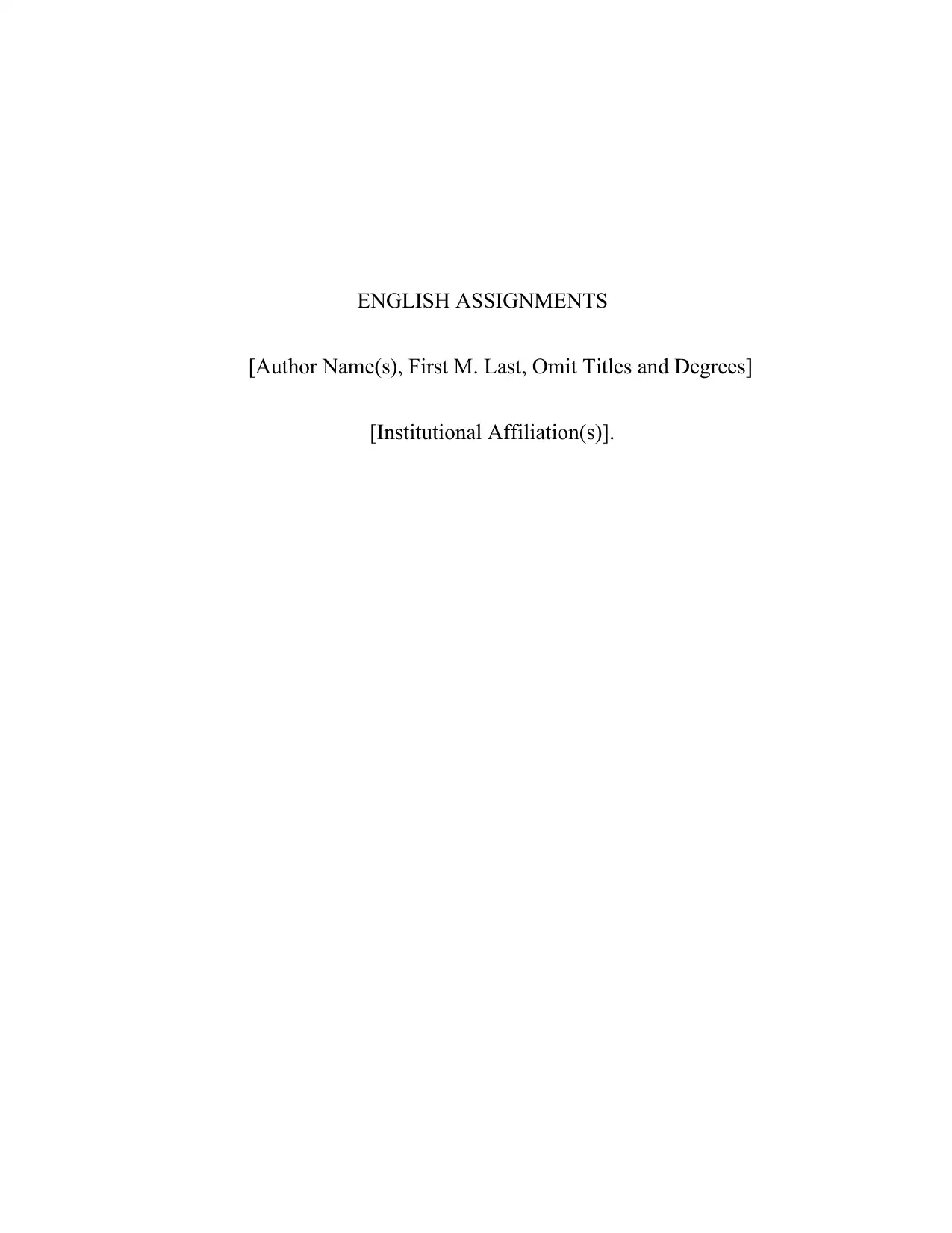
ENGLISH ASSIGNMENTS
[Author Name(s), First M. Last, Omit Titles and Degrees]
[Institutional Affiliation(s)].
[Author Name(s), First M. Last, Omit Titles and Degrees]
[Institutional Affiliation(s)].
Paraphrase This Document
Need a fresh take? Get an instant paraphrase of this document with our AI Paraphraser
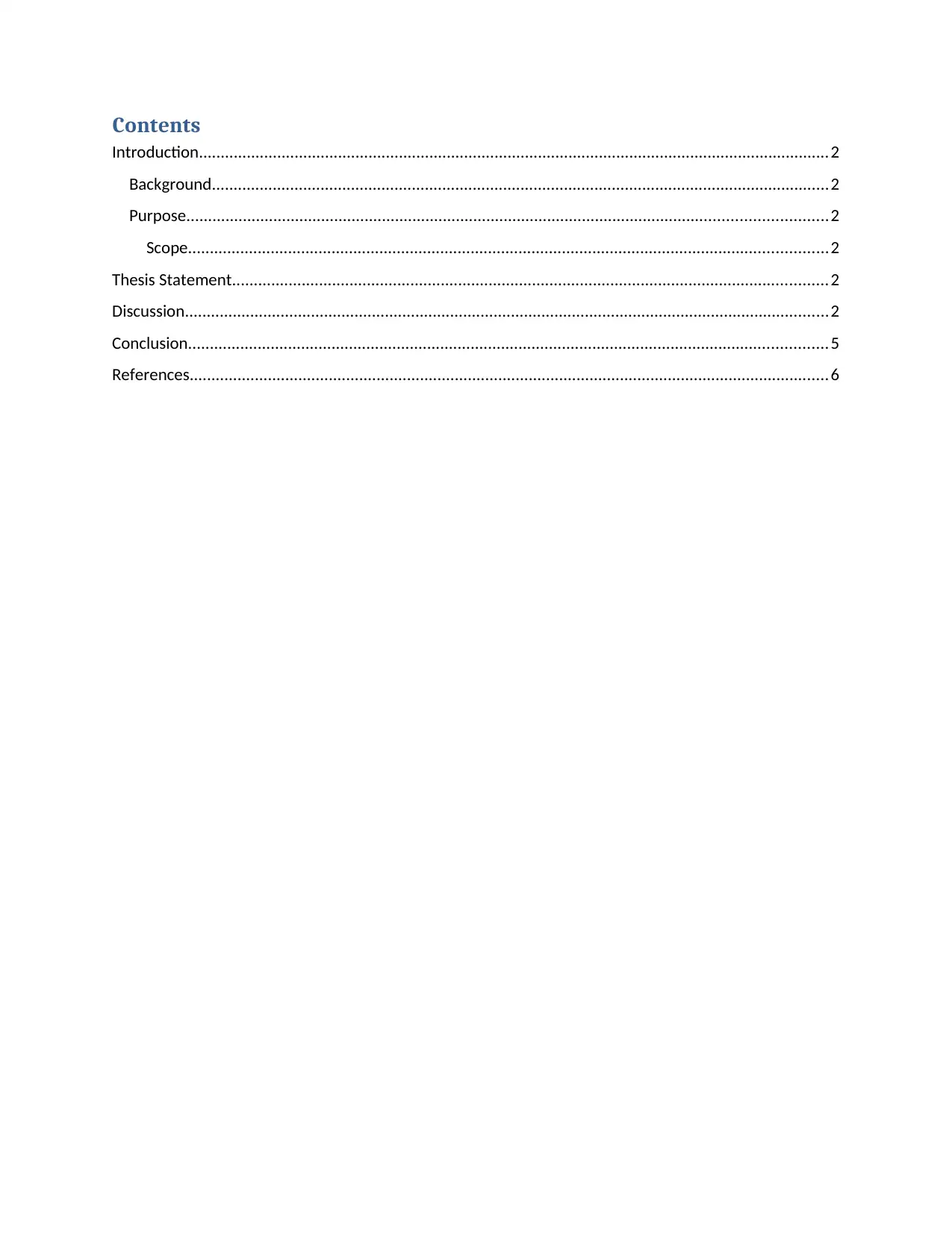
Contents
Introduction.................................................................................................................................................2
Background..............................................................................................................................................2
Purpose...................................................................................................................................................2
Scope...................................................................................................................................................2
Thesis Statement.........................................................................................................................................2
Discussion....................................................................................................................................................2
Conclusion...................................................................................................................................................5
References...................................................................................................................................................6
Introduction.................................................................................................................................................2
Background..............................................................................................................................................2
Purpose...................................................................................................................................................2
Scope...................................................................................................................................................2
Thesis Statement.........................................................................................................................................2
Discussion....................................................................................................................................................2
Conclusion...................................................................................................................................................5
References...................................................................................................................................................6

⊘ This is a preview!⊘
Do you want full access?
Subscribe today to unlock all pages.

Trusted by 1+ million students worldwide
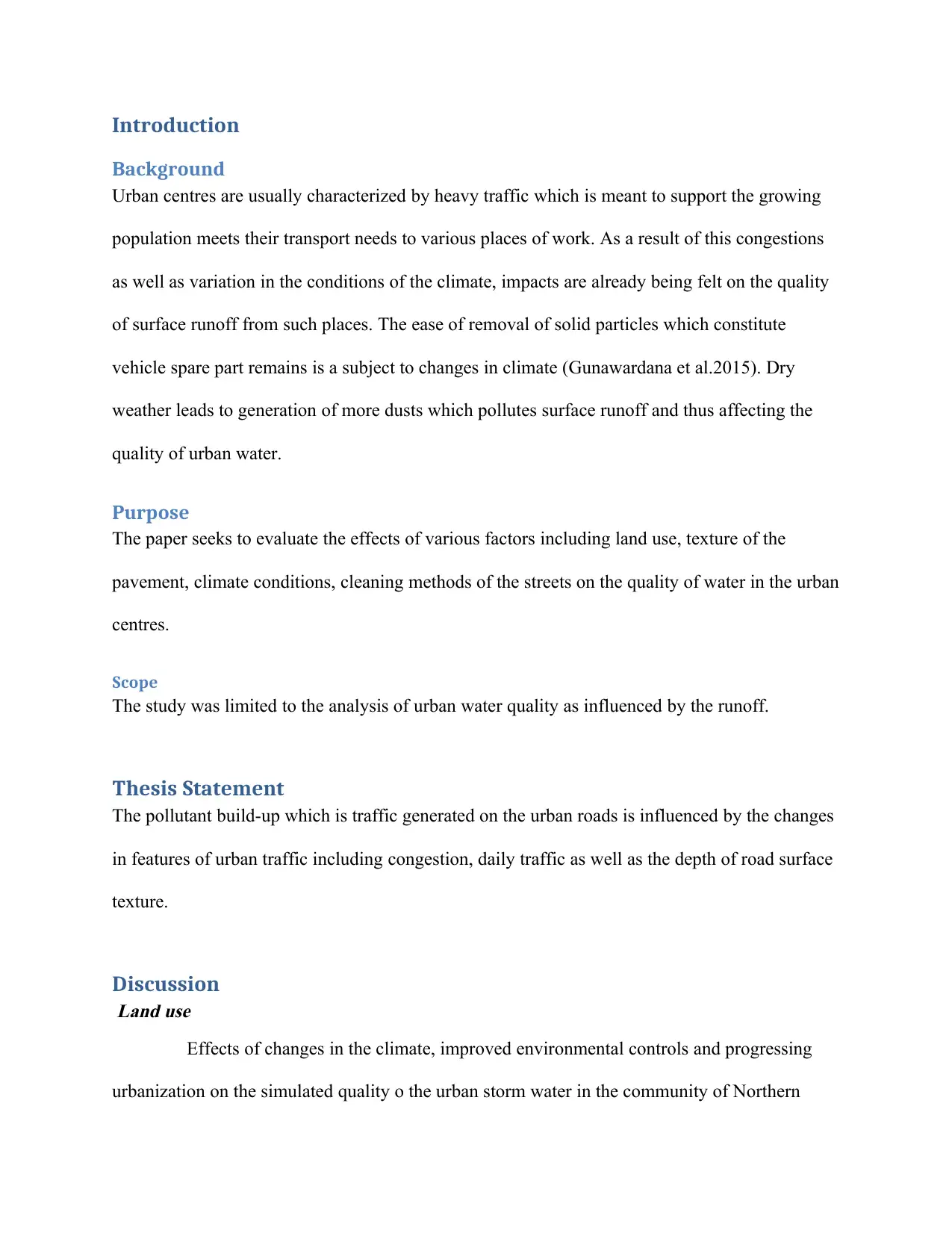
Introduction
Background
Urban centres are usually characterized by heavy traffic which is meant to support the growing
population meets their transport needs to various places of work. As a result of this congestions
as well as variation in the conditions of the climate, impacts are already being felt on the quality
of surface runoff from such places. The ease of removal of solid particles which constitute
vehicle spare part remains is a subject to changes in climate (Gunawardana et al.2015). Dry
weather leads to generation of more dusts which pollutes surface runoff and thus affecting the
quality of urban water.
Purpose
The paper seeks to evaluate the effects of various factors including land use, texture of the
pavement, climate conditions, cleaning methods of the streets on the quality of water in the urban
centres.
Scope
The study was limited to the analysis of urban water quality as influenced by the runoff.
Thesis Statement
The pollutant build-up which is traffic generated on the urban roads is influenced by the changes
in features of urban traffic including congestion, daily traffic as well as the depth of road surface
texture.
DiscussionLand use
Effects of changes in the climate, improved environmental controls and progressing
urbanization on the simulated quality o the urban storm water in the community of Northern
Background
Urban centres are usually characterized by heavy traffic which is meant to support the growing
population meets their transport needs to various places of work. As a result of this congestions
as well as variation in the conditions of the climate, impacts are already being felt on the quality
of surface runoff from such places. The ease of removal of solid particles which constitute
vehicle spare part remains is a subject to changes in climate (Gunawardana et al.2015). Dry
weather leads to generation of more dusts which pollutes surface runoff and thus affecting the
quality of urban water.
Purpose
The paper seeks to evaluate the effects of various factors including land use, texture of the
pavement, climate conditions, cleaning methods of the streets on the quality of water in the urban
centres.
Scope
The study was limited to the analysis of urban water quality as influenced by the runoff.
Thesis Statement
The pollutant build-up which is traffic generated on the urban roads is influenced by the changes
in features of urban traffic including congestion, daily traffic as well as the depth of road surface
texture.
DiscussionLand use
Effects of changes in the climate, improved environmental controls and progressing
urbanization on the simulated quality o the urban storm water in the community of Northern
Paraphrase This Document
Need a fresh take? Get an instant paraphrase of this document with our AI Paraphraser
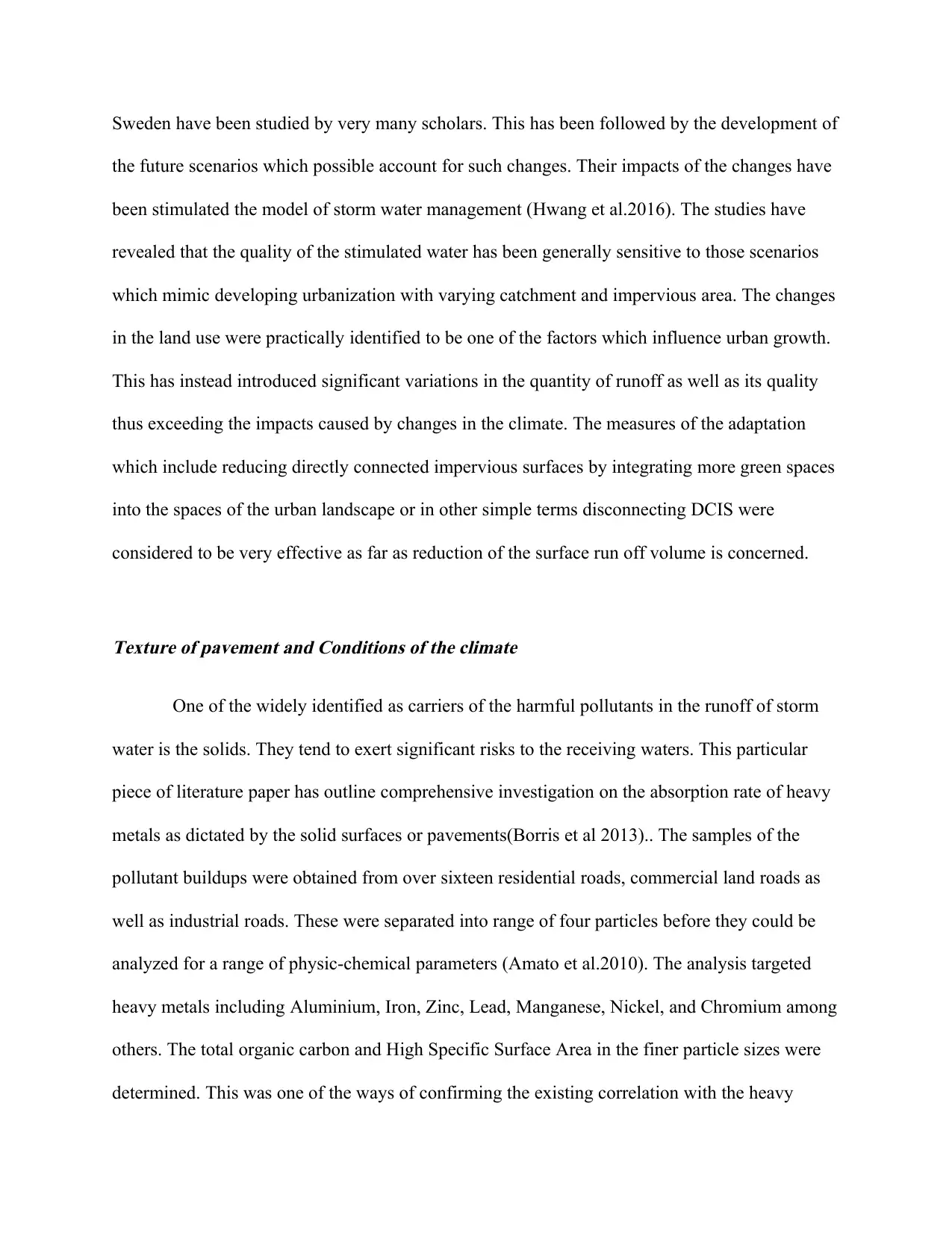
Sweden have been studied by very many scholars. This has been followed by the development of
the future scenarios which possible account for such changes. Their impacts of the changes have
been stimulated the model of storm water management (Hwang et al.2016). The studies have
revealed that the quality of the stimulated water has been generally sensitive to those scenarios
which mimic developing urbanization with varying catchment and impervious area. The changes
in the land use were practically identified to be one of the factors which influence urban growth.
This has instead introduced significant variations in the quantity of runoff as well as its quality
thus exceeding the impacts caused by changes in the climate. The measures of the adaptation
which include reducing directly connected impervious surfaces by integrating more green spaces
into the spaces of the urban landscape or in other simple terms disconnecting DCIS were
considered to be very effective as far as reduction of the surface run off volume is concerned.
Texture of pavement and Conditions of the climate
One of the widely identified as carriers of the harmful pollutants in the runoff of storm
water is the solids. They tend to exert significant risks to the receiving waters. This particular
piece of literature paper has outline comprehensive investigation on the absorption rate of heavy
metals as dictated by the solid surfaces or pavements(Borris et al 2013).. The samples of the
pollutant buildups were obtained from over sixteen residential roads, commercial land roads as
well as industrial roads. These were separated into range of four particles before they could be
analyzed for a range of physic-chemical parameters (Amato et al.2010). The analysis targeted
heavy metals including Aluminium, Iron, Zinc, Lead, Manganese, Nickel, and Chromium among
others. The total organic carbon and High Specific Surface Area in the finer particle sizes were
determined. This was one of the ways of confirming the existing correlation with the heavy
the future scenarios which possible account for such changes. Their impacts of the changes have
been stimulated the model of storm water management (Hwang et al.2016). The studies have
revealed that the quality of the stimulated water has been generally sensitive to those scenarios
which mimic developing urbanization with varying catchment and impervious area. The changes
in the land use were practically identified to be one of the factors which influence urban growth.
This has instead introduced significant variations in the quantity of runoff as well as its quality
thus exceeding the impacts caused by changes in the climate. The measures of the adaptation
which include reducing directly connected impervious surfaces by integrating more green spaces
into the spaces of the urban landscape or in other simple terms disconnecting DCIS were
considered to be very effective as far as reduction of the surface run off volume is concerned.
Texture of pavement and Conditions of the climate
One of the widely identified as carriers of the harmful pollutants in the runoff of storm
water is the solids. They tend to exert significant risks to the receiving waters. This particular
piece of literature paper has outline comprehensive investigation on the absorption rate of heavy
metals as dictated by the solid surfaces or pavements(Borris et al 2013).. The samples of the
pollutant buildups were obtained from over sixteen residential roads, commercial land roads as
well as industrial roads. These were separated into range of four particles before they could be
analyzed for a range of physic-chemical parameters (Amato et al.2010). The analysis targeted
heavy metals including Aluminium, Iron, Zinc, Lead, Manganese, Nickel, and Chromium among
others. The total organic carbon and High Specific Surface Area in the finer particle sizes were
determined. This was one of the ways of confirming the existing correlation with the heavy
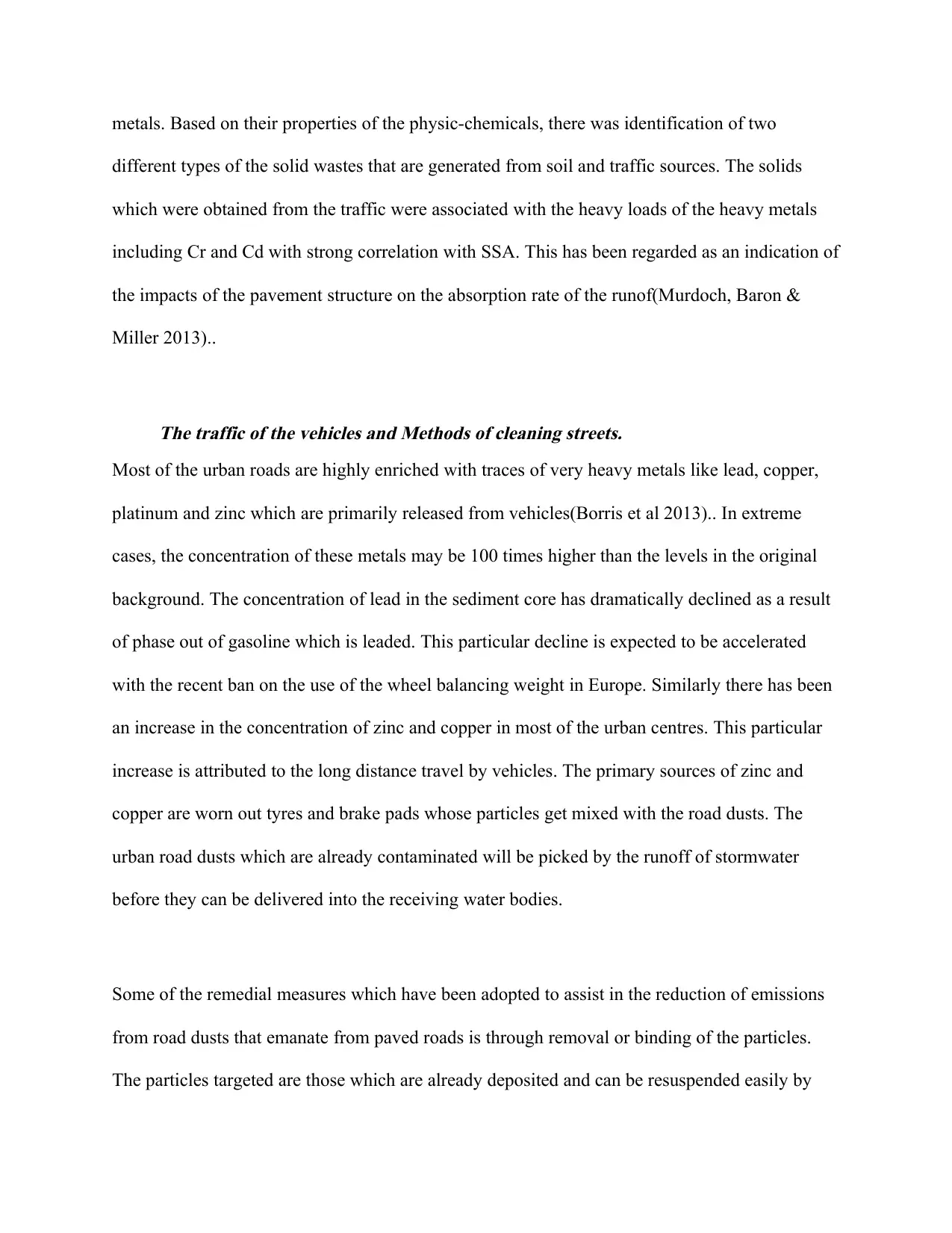
metals. Based on their properties of the physic-chemicals, there was identification of two
different types of the solid wastes that are generated from soil and traffic sources. The solids
which were obtained from the traffic were associated with the heavy loads of the heavy metals
including Cr and Cd with strong correlation with SSA. This has been regarded as an indication of
the impacts of the pavement structure on the absorption rate of the runof(Murdoch, Baron &
Miller 2013)..
The traffic of the vehicles and Methods of cleaning streets.
Most of the urban roads are highly enriched with traces of very heavy metals like lead, copper,
platinum and zinc which are primarily released from vehicles(Borris et al 2013).. In extreme
cases, the concentration of these metals may be 100 times higher than the levels in the original
background. The concentration of lead in the sediment core has dramatically declined as a result
of phase out of gasoline which is leaded. This particular decline is expected to be accelerated
with the recent ban on the use of the wheel balancing weight in Europe. Similarly there has been
an increase in the concentration of zinc and copper in most of the urban centres. This particular
increase is attributed to the long distance travel by vehicles. The primary sources of zinc and
copper are worn out tyres and brake pads whose particles get mixed with the road dusts. The
urban road dusts which are already contaminated will be picked by the runoff of stormwater
before they can be delivered into the receiving water bodies.
Some of the remedial measures which have been adopted to assist in the reduction of emissions
from road dusts that emanate from paved roads is through removal or binding of the particles.
The particles targeted are those which are already deposited and can be resuspended easily by
different types of the solid wastes that are generated from soil and traffic sources. The solids
which were obtained from the traffic were associated with the heavy loads of the heavy metals
including Cr and Cd with strong correlation with SSA. This has been regarded as an indication of
the impacts of the pavement structure on the absorption rate of the runof(Murdoch, Baron &
Miller 2013)..
The traffic of the vehicles and Methods of cleaning streets.
Most of the urban roads are highly enriched with traces of very heavy metals like lead, copper,
platinum and zinc which are primarily released from vehicles(Borris et al 2013).. In extreme
cases, the concentration of these metals may be 100 times higher than the levels in the original
background. The concentration of lead in the sediment core has dramatically declined as a result
of phase out of gasoline which is leaded. This particular decline is expected to be accelerated
with the recent ban on the use of the wheel balancing weight in Europe. Similarly there has been
an increase in the concentration of zinc and copper in most of the urban centres. This particular
increase is attributed to the long distance travel by vehicles. The primary sources of zinc and
copper are worn out tyres and brake pads whose particles get mixed with the road dusts. The
urban road dusts which are already contaminated will be picked by the runoff of stormwater
before they can be delivered into the receiving water bodies.
Some of the remedial measures which have been adopted to assist in the reduction of emissions
from road dusts that emanate from paved roads is through removal or binding of the particles.
The particles targeted are those which are already deposited and can be resuspended easily by
⊘ This is a preview!⊘
Do you want full access?
Subscribe today to unlock all pages.

Trusted by 1+ million students worldwide
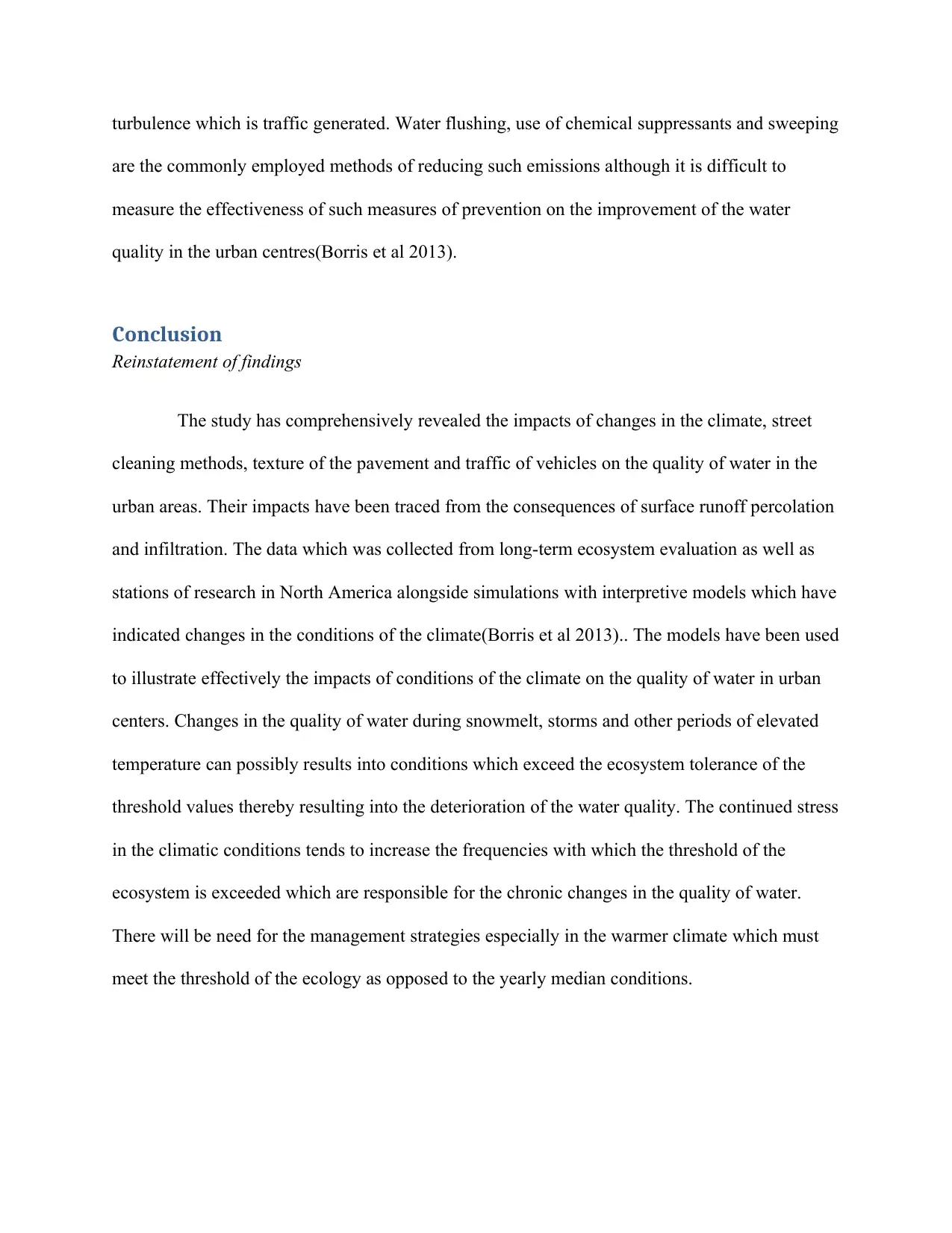
turbulence which is traffic generated. Water flushing, use of chemical suppressants and sweeping
are the commonly employed methods of reducing such emissions although it is difficult to
measure the effectiveness of such measures of prevention on the improvement of the water
quality in the urban centres(Borris et al 2013).
Conclusion
Reinstatement of findings
The study has comprehensively revealed the impacts of changes in the climate, street
cleaning methods, texture of the pavement and traffic of vehicles on the quality of water in the
urban areas. Their impacts have been traced from the consequences of surface runoff percolation
and infiltration. The data which was collected from long-term ecosystem evaluation as well as
stations of research in North America alongside simulations with interpretive models which have
indicated changes in the conditions of the climate(Borris et al 2013).. The models have been used
to illustrate effectively the impacts of conditions of the climate on the quality of water in urban
centers. Changes in the quality of water during snowmelt, storms and other periods of elevated
temperature can possibly results into conditions which exceed the ecosystem tolerance of the
threshold values thereby resulting into the deterioration of the water quality. The continued stress
in the climatic conditions tends to increase the frequencies with which the threshold of the
ecosystem is exceeded which are responsible for the chronic changes in the quality of water.
There will be need for the management strategies especially in the warmer climate which must
meet the threshold of the ecology as opposed to the yearly median conditions.
are the commonly employed methods of reducing such emissions although it is difficult to
measure the effectiveness of such measures of prevention on the improvement of the water
quality in the urban centres(Borris et al 2013).
Conclusion
Reinstatement of findings
The study has comprehensively revealed the impacts of changes in the climate, street
cleaning methods, texture of the pavement and traffic of vehicles on the quality of water in the
urban areas. Their impacts have been traced from the consequences of surface runoff percolation
and infiltration. The data which was collected from long-term ecosystem evaluation as well as
stations of research in North America alongside simulations with interpretive models which have
indicated changes in the conditions of the climate(Borris et al 2013).. The models have been used
to illustrate effectively the impacts of conditions of the climate on the quality of water in urban
centers. Changes in the quality of water during snowmelt, storms and other periods of elevated
temperature can possibly results into conditions which exceed the ecosystem tolerance of the
threshold values thereby resulting into the deterioration of the water quality. The continued stress
in the climatic conditions tends to increase the frequencies with which the threshold of the
ecosystem is exceeded which are responsible for the chronic changes in the quality of water.
There will be need for the management strategies especially in the warmer climate which must
meet the threshold of the ecology as opposed to the yearly median conditions.
Paraphrase This Document
Need a fresh take? Get an instant paraphrase of this document with our AI Paraphraser
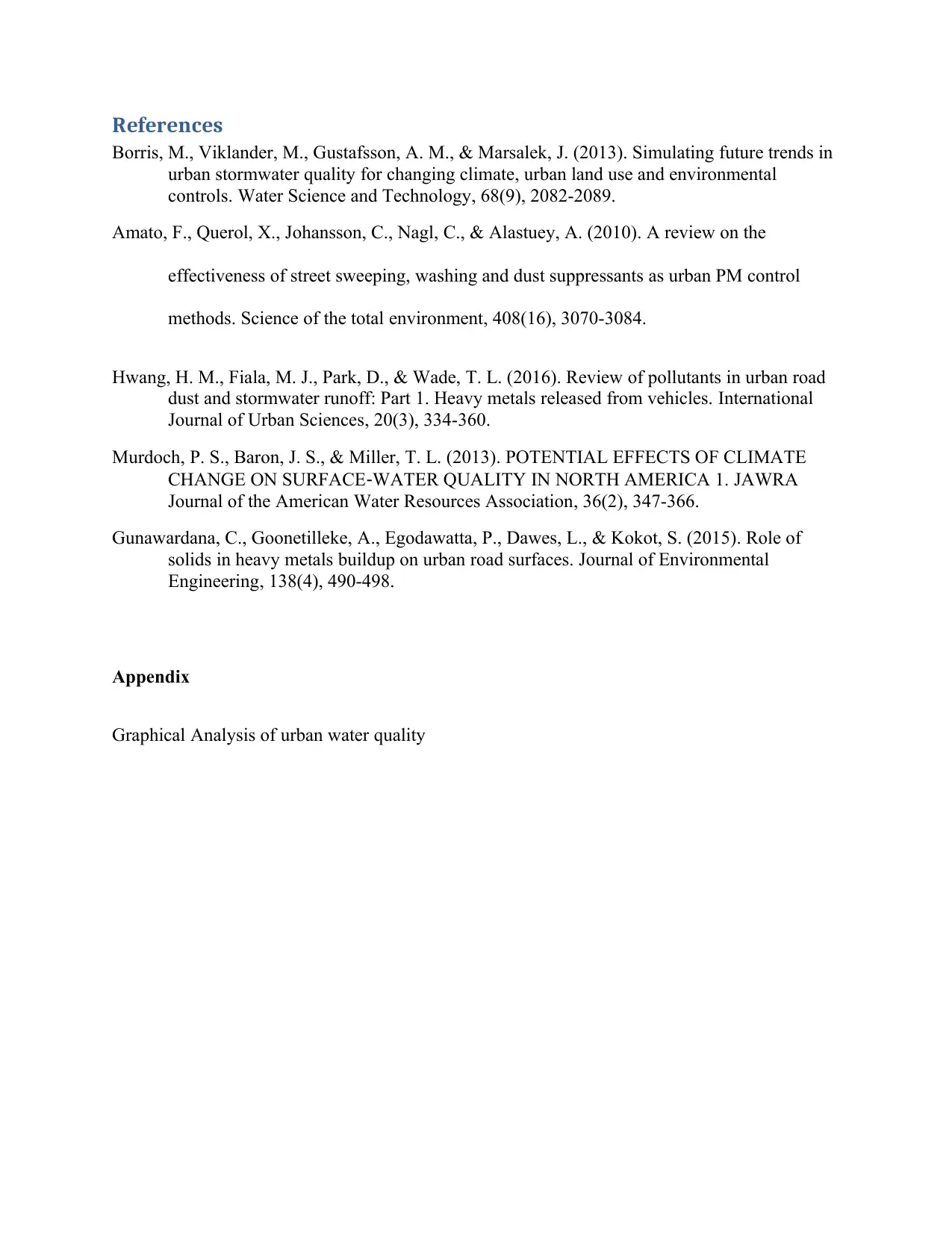
References
Borris, M., Viklander, M., Gustafsson, A. M., & Marsalek, J. (2013). Simulating future trends in
urban stormwater quality for changing climate, urban land use and environmental
controls. Water Science and Technology, 68(9), 2082-2089.
Amato, F., Querol, X., Johansson, C., Nagl, C., & Alastuey, A. (2010). A review on the
effectiveness of street sweeping, washing and dust suppressants as urban PM control
methods. Science of the total environment, 408(16), 3070-3084.
Hwang, H. M., Fiala, M. J., Park, D., & Wade, T. L. (2016). Review of pollutants in urban road
dust and stormwater runoff: Part 1. Heavy metals released from vehicles. International
Journal of Urban Sciences, 20(3), 334-360.
Murdoch, P. S., Baron, J. S., & Miller, T. L. (2013). POTENTIAL EFFECTS OF CLIMATE
CHANGE ON SURFACE‐WATER QUALITY IN NORTH AMERICA 1. JAWRA
Journal of the American Water Resources Association, 36(2), 347-366.
Gunawardana, C., Goonetilleke, A., Egodawatta, P., Dawes, L., & Kokot, S. (2015). Role of
solids in heavy metals buildup on urban road surfaces. Journal of Environmental
Engineering, 138(4), 490-498.
Appendix
Graphical Analysis of urban water quality
Borris, M., Viklander, M., Gustafsson, A. M., & Marsalek, J. (2013). Simulating future trends in
urban stormwater quality for changing climate, urban land use and environmental
controls. Water Science and Technology, 68(9), 2082-2089.
Amato, F., Querol, X., Johansson, C., Nagl, C., & Alastuey, A. (2010). A review on the
effectiveness of street sweeping, washing and dust suppressants as urban PM control
methods. Science of the total environment, 408(16), 3070-3084.
Hwang, H. M., Fiala, M. J., Park, D., & Wade, T. L. (2016). Review of pollutants in urban road
dust and stormwater runoff: Part 1. Heavy metals released from vehicles. International
Journal of Urban Sciences, 20(3), 334-360.
Murdoch, P. S., Baron, J. S., & Miller, T. L. (2013). POTENTIAL EFFECTS OF CLIMATE
CHANGE ON SURFACE‐WATER QUALITY IN NORTH AMERICA 1. JAWRA
Journal of the American Water Resources Association, 36(2), 347-366.
Gunawardana, C., Goonetilleke, A., Egodawatta, P., Dawes, L., & Kokot, S. (2015). Role of
solids in heavy metals buildup on urban road surfaces. Journal of Environmental
Engineering, 138(4), 490-498.
Appendix
Graphical Analysis of urban water quality
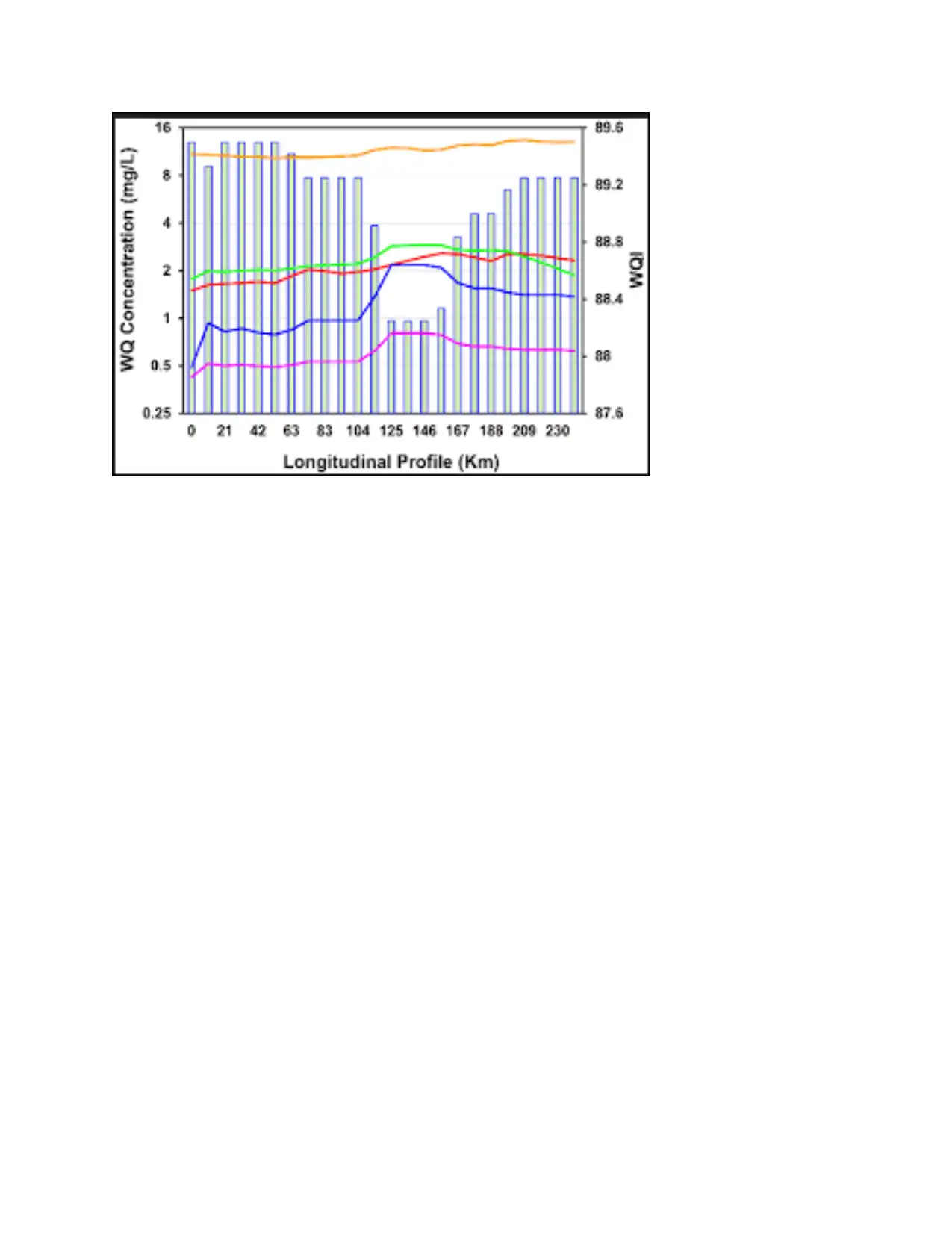
⊘ This is a preview!⊘
Do you want full access?
Subscribe today to unlock all pages.

Trusted by 1+ million students worldwide
1 out of 9
Related Documents
Your All-in-One AI-Powered Toolkit for Academic Success.
+13062052269
info@desklib.com
Available 24*7 on WhatsApp / Email
![[object Object]](/_next/static/media/star-bottom.7253800d.svg)
Unlock your academic potential
Copyright © 2020–2025 A2Z Services. All Rights Reserved. Developed and managed by ZUCOL.




